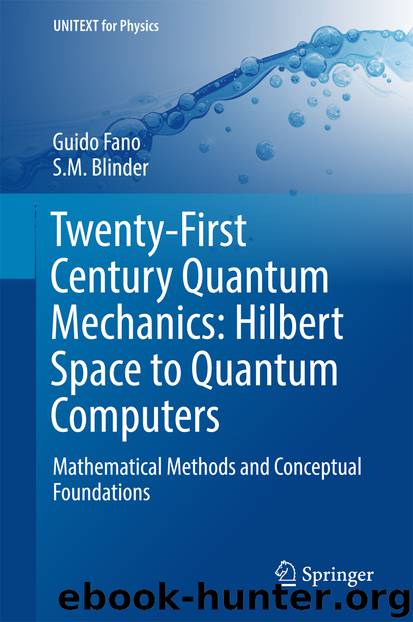Twenty-First Century Quantum Mechanics: Hilbert Space to Quantum Computers by Guido Fano & S M Blinder

Author:Guido Fano & S M Blinder
Language: eng
Format: epub
Publisher: Springer International Publishing, Cham
Of course, most physicists do not believe that the current interpretation of QM will survive forever. Among other things, QM relies strongly upon linearity, while modern physics has uncovered a preponderance of nonlinear phenomena in nature. Also, it is recognized that quantum mechanics remains incomplete until it can be coherently incorporated into a “Theory of Everything,” which also contains general relativity. In fact, Penrose has proposed that quantum gravity is involved in the loss of coherence of a quantum state, which can purportedly occur whenever space-time curvature increases to a critical level (Penrose 1996). Probably the most popular current viewpoint is the hypothesis of decoherence, which we shall discuss further in Chap. 5. Among other things, decoherence explains why a superposition state of macroscopic objects is generally extremely unstable: this helps to clarify the relation between classical and quantum mechanics. Some progress has recently been made by the consistent histories formalism of Gell-Mann, Griffiths, Hartle, and Omnes, (see Griffiths 2002, Omnes 1994, Zurek 1991), but it seems that the situation is still very fluid and far from being satisfactorily resolved.
We might also note that a number of even more exotic interpretations of quantum mechanics have been suggested. Everett and Wheeler once suggested the many worlds interpretation of quantum mechanics, in which each random event causes the splitting of the entire Universe into disconnected parallel Universes, in each of which, one possible outcome becomes the reality. David Deutsch (1997) believes that the implicit large-scale parallel processing by a quantum computer can be explained only by the many worlds interpretation of QM. Needless to say, not many people are willing to accept such a metaphysically unwieldy view of reality. Most scientists are content to apply the highly successful computational mechanisms of quantum theory to their work, without worrying unduly about its philosophical underpinnings. As Feynman put it, “Shut up and calculate!” Much like most of us happily using our computers without acquiring a detailed knowledge of either semiconductor technology or operating system programming.
The dichotomy of appearance and reality is, in fact, not limited to the quantum theory, but pervades much of modern science. It applies notably to neuroscience, regarding the origin of consciousness. In our daily lives, we intuitively assume that our perceptions, visual, auditory, tactile, etc., actually represent the “real world.” This simulation has evidently been a reasonably successful one for the human race. Otherwise natural selection would have weeded us out by now. But philosophers, going back to Plato/Aristotle, have recognized that our perceptions provide merely a model of external reality (recall Plato’s Parable of the Cave). The most elegant formulation of the dichotomy was given by Immanuel Kant in his Critique of Pure Reason. Kant distinguished the separate realms of phenomena and noumena. Phenomena are the experiences through our senses; noumena are the underlying things which actually constitute reality. Since the thing in itself (Ding an sich) is, by supposition, entirely beyond our capabilities, we must be completely unaware of the noumenal realm. This should provide a healthy dose
Download
This site does not store any files on its server. We only index and link to content provided by other sites. Please contact the content providers to delete copyright contents if any and email us, we'll remove relevant links or contents immediately.
The Complete Stick Figure Physics Tutorials by Allen Sarah(7273)
Secrets of Antigravity Propulsion: Tesla, UFOs, and Classified Aerospace Technology by Ph.D. Paul A. Laviolette(5247)
Thing Explainer by Randall Munroe(3854)
The River of Consciousness by Oliver Sacks(3505)
The Order of Time by Carlo Rovelli(3102)
How To by Randall Munroe(2979)
A Brief History of Time by Stephen Hawking(2918)
I Live in the Future & Here's How It Works by Nick Bilton(2907)
The Great Unknown by Marcus du Sautoy(2621)
What If?: Serious Scientific Answers to Absurd Hypothetical Questions by Randall Munroe(2595)
Midnight in Chernobyl by Adam Higginbotham(2439)
Blockchain: Ultimate Step By Step Guide To Understanding Blockchain Technology, Bitcoin Creation, and the future of Money (Novice to Expert) by Keizer Söze(2415)
Networks: An Introduction by Newman Mark(2310)
The Meaning of it All by Richard Feynman(2275)
Easy Electronics by Charles Platt(2257)
The Tao of Physics by Fritjof Capra(2209)
Midnight in Chernobyl: The Untold Story of the World's Greatest Nuclear Disaster by Adam Higginbotham(2133)
When by Daniel H Pink(2062)
Introducing Relativity by Bruce Bassett(2053)
